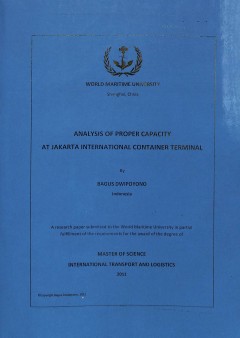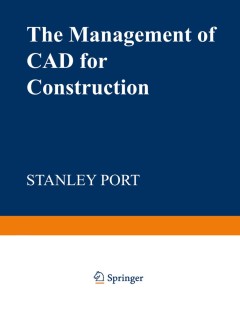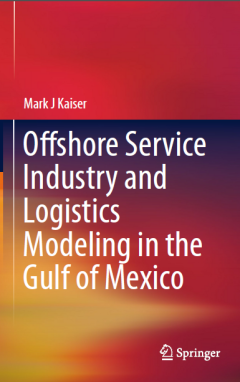Ditapis dengan

Bivariate Long Term Fuzzy Time Series Forecasting of Dry Cargo Freight Rates
This paper proposes a bivariate long term fuzzy inference system for time series forecasting task in the field of freight market. Fuzzy time series methods are applied by many scholars and it is broadly accepted pattern recognition and forecasting tool. Previous studies mainly establish algorithms for high frequency time series data such as daily and monthly intervals. The proposed model perfor…
- Edisi
- Volume 26 Number 2 December 2010 pp. 205-223
- ISBN/ISSN
- -
- Deskripsi Fisik
- 205 p.
- Judul Seri
- The Assian Journal of Shipping and Logistics
- No. Panggil
- ATC LO DUR b C.1

Prioritisation of performance indicators in air cargo demand management
Purpose – Real operational data are used to optimise the performance measurement of air cargo capacity demand management at Virgin Atlanticb Cargo by identifying the best KPIs from the range of outcome-based KPIs in current use. Design/methodology/approach – Intelligent fuzzy multi-criteria methods are used to generate a ranking order of key outcome-based performance indicators. More spec…
- Edisi
- -
- ISBN/ISSN
- 1359-8546
- Deskripsi Fisik
- -
- Judul Seri
- -
- No. Panggil
- ATC LO MAY p

Twenty years of IJLM: evolution in research
The purpose of this paper is to evaluate research trends observed in the International Journal of Logistics Management (IJLM) during its first 20 years of publication. Design/methodology/approach – A content analysis was conducted of the IJLM’s first 20 years of publication (330 articles in total) to identify changing trends in subject matter, use of theory, type of research methodology, an…
- Edisi
- Vol. 23 No. 1, 2012 pp. 4-30
- ISBN/ISSN
- 0957-4093
- Deskripsi Fisik
- 29 p.
- Judul Seri
- The International Journal of Logistics Management
- No. Panggil
- ATC LO TRO t C.1

Analysing Materials Handling Needs in Concurrent/Simultaneous Engineering
In simultaneous/concurrent engineering (SE/CE), many functions are performed concurrently; however, manufacturing logistics design is seldom considered. Presents an integrated methodology for the design of manufacturing logistics and links it with early phases of product design. The concept of “adaptability factor” is proposed, linking choice of manufacturing technology to handling operatio…
- Edisi
- Management, Vol. 14 No. 9, 1994, pp. 68-82.
- ISBN/ISSN
- 0144-3577
- Deskripsi Fisik
- 17 p.
- Judul Seri
- International Journal of Operations & Production Management
- No. Panggil
- ATC LO GUP a C.1

A generalized two-sex logistic model
We provide a generalization of the logistic two-sex model with ephemeral pair-bonds and with stable couples without assuming any specific mathematical form for fertility, mortality and the mating function. In particular, we establish a necessary and sufficient condition on the fertility/mortality density-dependent ratio that ensures the existence of the logistic behaviour. Several differences a…
- Edisi
- Vol. 7, No. 1, 302–318
- ISBN/ISSN
- 1751-3766
- Deskripsi Fisik
- 18 p.
- Judul Seri
- Journal of Biological Dynamics
- No. Panggil
- ATC LO MAX a C.1

Hybrid approach for container terminals performances evaluation and analysis
Turnaround time, defined as the total time spent by a vessel within the port area, is one of the most important key performance measures for a container terminal. In this paper, the authors propose a hybrid approach based on simulation and genetic algorithms to investigate vessels’ turnaround time in a real container terminal under different scenarios characterised by increases in containers …
- Edisi
- Vol. 9, Nos. 1/2, 2014
- ISBN/ISSN
- -
- Deskripsi Fisik
- 9 p.
- Judul Seri
- Int. J. Simulation and Process Modelling
- No. Panggil
- ACT MG NIC h C.1

Port competition modeling including maritime, port, and hinterland characteri…
- Edisi
- Vol. 37 Issue: 3, pp. 179-194
- ISBN/ISSN
- 1464–5254
- Deskripsi Fisik
- -
- Judul Seri
- Maritime Policy & Management: The flagship journal of international shipping and port research
- No. Panggil
- ATC PO ZON p
- Edisi
- Vol. 37 Issue: 3, pp. 179-194
- ISBN/ISSN
- 1464–5254
- Deskripsi Fisik
- -
- Judul Seri
- Maritime Policy & Management: The flagship journal of international shipping and port research
- No. Panggil
- ATC PO ZON p

Onboarding is a change: applying change management model ADKAR to onboarding
- Edisi
- Vol. 25 Issue: 7, pp. 5-8
- ISBN/ISSN
- 0967-0734
- Deskripsi Fisik
- -
- Judul Seri
- Human Resource Management International Digest
- No. Panggil
- ATC MG KAR o
- Edisi
- Vol. 25 Issue: 7, pp. 5-8
- ISBN/ISSN
- 0967-0734
- Deskripsi Fisik
- -
- Judul Seri
- Human Resource Management International Digest
- No. Panggil
- ATC MG KAR o

New Models for Sustainable Logistics Internalization of External Costs in Inv…
Logistics of transport systems is a key driver for the growth of whatever economy. Freight transport allows production systems or common citizens to receive or send materials or finished goods required by processes as well as by everyday life However, the overall transport sector accounts worldwide for more than half of global liquid fossil fuels consumptions which, in turn, is responsible for …
- Edisi
- 2015
- ISBN/ISSN
- 978-3-319-19710-4
- Deskripsi Fisik
- 111P
- Judul Seri
- New Models for Sustainable Logistics
- No. Panggil
- ATC MG DIG n

A business process approach to human resource management
- Edisi
- -
- ISBN/ISSN
- -
- Deskripsi Fisik
- -
- Judul Seri
- -
- No. Panggil
- ATC MG CAK b
- Edisi
- -
- ISBN/ISSN
- -
- Deskripsi Fisik
- -
- Judul Seri
- -
- No. Panggil
- ATC MG CAK b

A meta-analysis of DEA and SFA studies of the technical efficiency of seaport
This paper presents a meta-analysis of variations in seaports’ Mean Technical Efficiency (MTE) scores based on 40 studies published in refereed academic journals. We link the variation in estimated MTE scores to differences in the following factors: the frontier methodology used, which essentially are the Data Envelopment Analysis (DEA) and the Stochastic Frontier Analysis (SFA); regions wher…
- Edisi
- -
- ISBN/ISSN
- -
- Deskripsi Fisik
- 12 p .
- Judul Seri
- Transportation Research Part A
- No. Panggil
- ATC MG BRA a

Trojan horses of decline : hidden threats in your business model and how to r…
Most management literature addresses the symptoms of corporate collapse. But René R. Seyger takes another approach in Trojan Horses of Decline, drilling down the strategic heart of downfall. The roots of decline are not found in external forces like economic downturns. Decline's roots lie deep within companies, and therefore well within a company's sphere of control. By harnessing the metaphor…
- Edisi
- -
- ISBN/ISSN
- 978-90-9026439-4
- Deskripsi Fisik
- xiv, 101 p.; 25 cm.
- Judul Seri
- -
- No. Panggil
- LC 650.1 SEY t

Analysis of proper capacity at Jakarta International Container Terminal
As a facility with high capital investment, container terminal tends to be operated with maximum capacity by using high utilization of facilities and equipment rather than a proper throughput. However, a high utilization is leading to the ships waiting time and as consequence lowering the service level. Therefore a study is needed to determine the proper capacity by considering the interest of …
- Edisi
- -
- ISBN/ISSN
- -
- Deskripsi Fisik
- xiii, 100 p., ; illus : 30 cm ; bibliography
- Judul Seri
- -
- No. Panggil
- TD PO DWI a C.1

Business model generation
Business Model Generation is a handbook for visionaries, game changers, and challengers striving to defy outmoded business models and design tomorrow's enterprises. If your organization needs to adapt to harsh new realities, but you don't yet have a strategy that will get you out in front of your competitors, you need Business Model Generation…
- Edisi
- -
- ISBN/ISSN
- 978-0-470-87641-1
- Deskripsi Fisik
- 278 p, 19 cm ; picture
- Judul Seri
- -
- No. Panggil
- 650.1 OST b

U.S. import/export container flow modeling and disruption analysis
International containerized freight movement is a vital part of the supply chain for many companies, anda critical element of moving consumer goods to points of retail sale within the U.S. Containerized imports also present a clear security concern (e.g., terrorists attempting to ship “dirty bombs,” chemical, biological or even nuclear weapons, into the U.S. in a shipping container). The go…
- Edisi
- 32 (2011) 3e14
- ISBN/ISSN
- 0739-8859
- Deskripsi Fisik
- 12 p.
- Judul Seri
- Research in Transportation Economics
- No. Panggil
- ATC LO JON u

Tactical planning models for managing container flow and ship deployment
This paper addresses two practical problems from a liner shipping company, i.e. the container flow management problem and the ship deployment problem, at the tactical planning level. A sequential model and a joint optimisation model are formulated to solve the problems. Our results show that the company should implement the joint optimisation model at the tactical planning level to improve the …
- Edisi
- VOL. 38, NO. 5, 487–508
- ISBN/ISSN
- 1464–5254
- Deskripsi Fisik
- 23 p.
- Judul Seri
- Tactical planning models
- No. Panggil
- ATC LO LIU t

Relevance of City Logistics Modelling Efforts: A Review
This paper presents a review of city logistics (also known as urban freight transportation) modelling efforts reported in the literature for urban freight analysis. The review is based on an extensive search of the academic literature. We position the contributions in a framework that takes into account the diversity and complexity found in the present-day city logistics practice. The framework…
- Edisi
- 2015
- ISBN/ISSN
- 1464-5327
- Deskripsi Fisik
- 20 p.
- Judul Seri
- Transport Reviews A Transnational Transdisciplinary Journal
- No. Panggil
- ATC LO ANA r

Port e-Transformation, customer satisfaction and competitiveness
e-Transformation in container ports means port organization-wide innovative transformation encompassing internal and external value chains based on information and communication technology. There is a considerable theoretical literature on the impact of e-Transformation on business performance, but there is very little empirical study on its effectiveness in ports. The objective of this paper i…
- Edisi
- 2015
- ISBN/ISSN
- 1464-5254
- Deskripsi Fisik
- 15 p.
- Judul Seri
- Maritime Policy & Management The flagship journal of international shipping and port research
- No. Panggil
- ATC LO LEE p

Optimal stack layout in a sea container terminal with automated lifting vehicles
Container terminal performance is largely determined by its design decisions, which include the number and type of quay cranes, stack cranes, transport vehicles, vehicle travel path and stack layout.We investigate the orientation of the stack layout (parallel or perpendicular to the quayside) on the throughput time performance of the terminals. Previous studies in this area typically use deter…
- Edisi
- 2017
- ISBN/ISSN
- 1366-588X
- Deskripsi Fisik
- 20P
- Judul Seri
- International Journal of Production Research
- No. Panggil
- ATC LO GUP o

Optimal pricing and terminal location for a rail–truck intermodal service �…
To be competitive with other modes of transport, railways need to be cost-effective. In order to become more competitive in the logistics sector, Indian Railways has taken new initiatives to improve their operations in recent years. A rail–truck intermodal transportation service for Indian Railways is described in this paper. The main focus of the research presented in this paper is on the jo…
- Edisi
- Vol. 14, No. 5, October 2011, 335–349
- ISBN/ISSN
- 1469-848X
- Deskripsi Fisik
- 17 p.
- Judul Seri
- International Journal of Logistics Research and Applications: A Leading Journal of Supply Chain Management
- No. Panggil
- ATC LO DAN o

Optimal location and size of logistics parks in a regional logistics network …
This paper proposes a model to address the design problem of a regional logistics network. In the proposed model, the decision variables include the location and size of logistics parks. The interaction between the logistics authority and logistics users as well as the effects of economies of scale and CO2 emission taxes on the logistics network design are explicitly considered. The proposed mo…
- Edisi
- 2015
- ISBN/ISSN
- 1648-3480
- Deskripsi Fisik
- 18 p.
- Judul Seri
- Transport
- No. Panggil
- ATC LO ZHA o

Multicommodity network flow model for Asia's container ports
This paper seeks to develop a multi-commodity network model to analyse the flow of containers within the Asia Pacific context. The model is used to evaluate the impact of container throughput in Asia’s port by varying terminal handling charges and turnaround time. The three main regions analysed are north-east Asia, east Asia (Chinese port region) and south east Asia. Using the model, it coul…
- Edisi
- VOL. 33, NO. 4, 387–402
- ISBN/ISSN
- 1464–5254
- Deskripsi Fisik
- 18 p.
- Judul Seri
- Maritime Policy & Management: The flagship journal of international shipping and port research
- No. Panggil
- ATC LO LEE m

Model warehouse
This paper puts forward a new conception: model warehouse, analyzes the reason why model warehouse appears and introduces the characteristics and architecture of model warehouse. Last, this paper points out that model warehouse is an important part of WebGIS_
- Edisi
- Volume 6, Issue 1, Page 62-65 March 2003
- ISBN/ISSN
- -
- Deskripsi Fisik
- 5 p.
- Judul Seri
- Geo-spatial Information Science
- No. Panggil
- ATC LO ZHI m

Forecasting container throughput using aggregate or terminal-specific data? T…
We propose a new approach to forecasting total port container throughput: to generate forecasts based on each of the port’s terminals and aggregate them into the total throughput forecast. We forecast the demand for total container throughput at the Indonesia’s largest seaport Tanjung Priok Port, employing SARIMA, the additive and multiplicative Seasonal Holt-Winters (MSHW) and the Vector E…
- Edisi
- 2016
- ISBN/ISSN
- 1366-588X
- Deskripsi Fisik
- 17 p.
- Judul Seri
- International Journal of Production Research
- No. Panggil
- ATC LO FAN f

Dynamics of Dry Bulk Freight Market: Through the Lens of a Common Stochastic …
This paper shows the possibility that, as a simple average, BDI occasionally over- or under-states the status of global dry bulk freight market. In order to overcome this shortcoming, this paper suggests an alternative method of calculating new index by using a common stochastic trend model. This econometric approach to understanding the dynamics of dry bulk freight markets not only provides ne…
- Edisi
- Volume 27 Number 3 December 2011 pp. 387-404
- ISBN/ISSN
- -
- Deskripsi Fisik
- 18 p.
- Judul Seri
- The Asian Ournal of Shipping and Logistic
- No. Panggil
- ATC LO WOO d

An Activity-Based Costing Model for Logistics Operations of Manufacturers and…
The logistics costs of industrial enterprises in a supply chain are studied. The following aspects of logistics costs are included: an ABC (Activity-Based Costing) calculation model for logistics; average logistics costs of Finnish industrial manufacturers and suppliers; the factors which in¯ uence a company’s cost ef® ciency in logistics; and an ABC simulation model for the logistics costs…
- Edisi
- Vol. 3, No. 1, 2000
- ISBN/ISSN
- 1469-848X
- Deskripsi Fisik
- 15p
- Judul Seri
- International Journal of Logistics Research and Applications: A Leading Journal of Supply Chain Management
- No. Panggil
- ATC LO MAN a

A stochastic frontier model of the productive efficiency of Korean container …
A central objective of port privatization and/or deregulation policies is stimulating greater efficiency by engendering a more competitive market and commercial approach to management. Korea provides a prime example of a nation that is implementing such policies. Also, its ports play a pivotal role in world shipping, particularly in the ever-burgeoning container market. The success of these pol…
- Edisi
- 2003
- ISBN/ISSN
- 1466–4283
- Deskripsi Fisik
- 18p
- Judul Seri
- Applied Economics
- No. Panggil
- ATC LO CUL a

A stochastic frontier model of the efficiency of major container terminals in…
This paper applies a ‘port function matrix’ to analyse the administrative and ownership structures of major container ports in Asia. The relative efficiency of these ports is then assessed using the cross-sectional and panel data versions of the ‘stochastic frontier model’. The estimated efficiency measures are broadly similar for the two versions of the model tested. From the results o…
- Edisi
- 2002
- ISBN/ISSN
- -
- Deskripsi Fisik
- 21p
- Judul Seri
- Transportation Research Part A
- No. Panggil
- ATC LO CUL a

Innovating business models and attracting different intellectual capabilities
When practicing innovation, attracting different intellectual capabilities (ICAs) is extremely important. The reasoning is that innovation necessitates different ICA that can think differently together. Continuous pressure on finding, attracting and applying ‘‘the right intellectual capability’’ related to the task is interesting. This article aims to examine how to attract and apply IC…
- Edisi
- VOL. 13 NO. 2 2009, pp. 17-24,
- ISBN/ISSN
- 1368-3047
- Deskripsi Fisik
- 10P
- Judul Seri
- Measuring Business Excellence
- No. Panggil
- ATC LE LIN i

Evaluation of alternative logistics operations for the national supply of an …
One result of the continuing current competitive environment in Australia is cost pressure on the supply of manufacturing commodities such as anhydrous sodium sulphate. Commodity suppliers do not have much scope for providing value-added services. Anhydrous sodium sulphate, for example, is mostly brought to the customer’s attention when negative service characteristics occur – stocks run lo…
- Edisi
- Vol. 28 No. 5, 1998, pp. 382-395
- ISBN/ISSN
- 0960-0035
- Deskripsi Fisik
- 15 p
- Judul Seri
- International Journal of Physical Distribution & Logistics Management
- No. Panggil
- ATC LO GIL e

PORTSIM 5: Modeling from a Seaport Level
This paper describes PORTSIM 5, a discrete-event seaport simulation model. Specifically, we discuss the developmental efforts and existing system limitations that have led up to the current efforts being undertaken by the Military Traffic Management Command Transportation Engineering Agency and Argonne National Laboratory. PORTSIM 5 builds on the knowledge and expertise gained from two precedin…
- Edisi
- -
- ISBN/ISSN
- 0895-7177
- Deskripsi Fisik
- 17 p.
- Judul Seri
- Mathematical and Computer Modelling
- No. Panggil
- ATC PO ARD p

Hybrid approaches based on SARIMA and artificial neural networks for inspecti…
In this paper, the number of goods subject to inspection at European Border Inspections Post are predicted using a hybrid two-step procedure. A hybridization methodology based on integrating the data obtained from autoregressive integrated moving averages (SARIMA) model in the artificial neural network model (ANN) to predict the number of inspections is proposed. Several hybrid approaches are c…
- Edisi
- -
- ISBN/ISSN
- 1366-5545
- Deskripsi Fisik
- 13 p.
- Judul Seri
- Transportation Research Part E
- No. Panggil
- ATC PO LAR h

Estimating an origin–destination table for US imports of waterborne contain…
Containerized freight imports into the US are growing at an average of 10% per year. This traffic is concentrated at a small number of US seaports. It is therefore important to have an accurate understanding of the flow of containers from their origin country through these seaports to their final destination. This paper develops an optimization model to estimate route flows and a corresponding …
- Edisi
- -
- ISBN/ISSN
- 1366-5545
- Deskripsi Fisik
- 16 p.
- Judul Seri
- Transportation Research Part E
- No. Panggil
- ATC PO INE e

Estimate of main local sources to ambient ultrafine particle number concentra…
Quantifying and apportioning the contribution of a range of sources to ultrafine particles (UFPs, D < 100 nm) is a challenge due to the complex nature of the urban environments. Although vehicular emissions have long been considered one of the major sources of ultrafine particles in urban areas, the contribution of other major urban sources is not yet fully understood. This paper aims to determ…
- Edisi
- -
- ISBN/ISSN
- 0169-8095
- Deskripsi Fisik
- 12 p.
- Judul Seri
- Atmospheric Research
- No. Panggil
- ATC PO ANA e

Financial Approach for Solving Stakeholders’ Conflicts of Interests in Port…
This paper presents a conflict solving model to resolve different stakeholder demands in the port redevelopment of the Incheon Inner Port. The different interest groups involved in this current project in South Korea include the land owner of Incheon Port Authority (PA), governmental regulator of Ministry of Maritime and Fishery (MOMAF), private port interests, port labor, business interests an…
- Edisi
- Volume 29 Number 3 December 2103 pp. 315-334
- ISBN/ISSN
- -
- Deskripsi Fisik
- 20 p.
- Judul Seri
- The Assian Journal of Shipping and Logistics
- No. Panggil
- ATC MG PAR f C.1

Build-up of toxic metals on the impervious surfaces of a commercial seaport
In thecontextofincreasingthreatstothesensitivemarineecosystembytoxicmetals,thisstudyin- vestigatedthemetalbuild-uponimpervioussurfacesspecific tocommercialseaports.Theknowledge generatedfromthisstudywillcontributetomanagingtoxicmetalpollutionofthemarineecosystem. The studyfoundthatinter-modaloperationsandmainaccessroadwayhadthehighestloadsfollowedby container storageandvehiclemarshallingsites…
- Edisi
- -
- ISBN/ISSN
- 0147-6513
- Deskripsi Fisik
- 6 p.
- Judul Seri
- Ecotoxicology and Environmenta lSafety
- No. Panggil
- ATC PO ATH b

Using virtual worlds for collaborative business process modeling
Process modeling is a complex organizational task that requires many iterations and communication between the business analysts and the domain specialists. The challenge of process modeling is exacerbated, when the process of modeling has to be performed in a cross-organizational, distributed environment. This paper aims to suggest a three-dimensional (3D) environment for collaborative process …
- Edisi
- Vol. 17 No. 3, 2011 pp. 546-564
- ISBN/ISSN
- 1463-7154
- Deskripsi Fisik
- 20 p.
- Judul Seri
- Business Process Management Journal
- No. Panggil
- ATC MG BRO u

Management of disruptions by seaports: preliminary findings
The function of a port has evolved from a platform providing simple loading and unloading activities to a gateway that opens up numerous opportunities that proliferate economic benefits. The effects of globalization and modern supply chain trends have reinforced the role that ports play in supply chains. This calls for contemporary studies on supply chain management to expand to address the …
- Edisi
- Vol. 27 No. 1, 2015 pp. 146-162
- ISBN/ISSN
- 1355-5855
- Deskripsi Fisik
- 20 p.
- Judul Seri
- Asia Pacific Journal of Marketing and Logistics
- No. Panggil
- ATC MG LOH m

Managing port-related supply chain disruptions (PSCDs) : a management model a…
In the contemporary port business environment, port resilience is of paramount importance for supply chain continuity. A result of the increased integration of ports into supply chains is ports’ potential to supply chain disruptions. This paper introduces a PSCD management model that incorporates the application of risk management, business continuity management, and quality management theori…
- Edisi
- VOL. 43, NO. 4, 436–455
- ISBN/ISSN
- 1464-5254
- Deskripsi Fisik
- 21 p.
- Judul Seri
- Maritime Policy & Management
- No. Panggil
- ATC PO LOH m

A new risk assessment model for agricultural products cold chain logistics
- Edisi
- Vol. 117 Issue: 9, pp.1800-1816
- ISBN/ISSN
- -
- Deskripsi Fisik
- 19 p.
- Judul Seri
- Industrial Management & Data Systems
- No. Panggil
- ATC LO ZHA n
- Edisi
- Vol. 117 Issue: 9, pp.1800-1816
- ISBN/ISSN
- -
- Deskripsi Fisik
- 19 p.
- Judul Seri
- Industrial Management & Data Systems
- No. Panggil
- ATC LO ZHA n

The Management of CAD for construction
- Edisi
- -
- ISBN/ISSN
- 978-1-4684-6605-8
- Deskripsi Fisik
- xii, 228 p.
- Judul Seri
- -
- No. Panggil
- TXT MG STA m
- Edisi
- -
- ISBN/ISSN
- 978-1-4684-6605-8
- Deskripsi Fisik
- xii, 228 p.
- Judul Seri
- -
- No. Panggil
- TXT MG STA m

Offshore service industry and logistics modeling in the gulf of mexico
- Edisi
- -
- ISBN/ISSN
- 978-3-319-17013-8
- Deskripsi Fisik
- -
- Judul Seri
- -
- No. Panggil
- TXT LO Kai o
- Edisi
- -
- ISBN/ISSN
- 978-3-319-17013-8
- Deskripsi Fisik
- -
- Judul Seri
- -
- No. Panggil
- TXT LO Kai o

Maritime piracy and its control : an economic analysis
- Edisi
- -
- ISBN/ISSN
- 978-1-137-46150-6
- Deskripsi Fisik
- x, 135 p.
- Judul Seri
- -
- No. Panggil
- TXT MR HAL m
- Edisi
- -
- ISBN/ISSN
- 978-1-137-46150-6
- Deskripsi Fisik
- x, 135 p.
- Judul Seri
- -
- No. Panggil
- TXT MR HAL m

Supply demand chain modeling utilizing logistical-based costing
The purpose of this research is to describe how total cost concept with logistical based costing (LBC) is developed in detail and then used to build logistical models on the Microsoft Excele platform that are integrated from the customer’s factory to the supplier’s door.
- Edisi
- Vol. 19 No. 3, 2006
- ISBN/ISSN
- -
- Deskripsi Fisik
- 17 p.
- Judul Seri
- Journal of Enterprise Information Management
- No. Panggil
- ATC LO STO s

An optimization approach to risk decision-making of closed-loop logistics bas…
In green logistics operation, all logistics processes form a bidirectional closed-loop topology. In order to model and optimize such a kind of structure, a standardized closed-loop logistics operation reference model is built which aims to provide supply chain managers with general analysis. Based on the reference model, potential risks of closed-loop logistics chain can be analyzed including n…
- Edisi
- Vol. 61, No. 10, October 2012
- ISBN/ISSN
- -
- Deskripsi Fisik
- 32 p.
- Judul Seri
- Optimization: A Journal of Mathematical Programming and Operations Research
- No. Panggil
- ATC LO ZHA a

An emergency order allocation model based on multi-provider in two-echelon lo…
On one side, the purpose of this paper is to numerically analyze the emergency order allocation mechanism and help managers to understand the relationship between the emergency coefficient, uncertainty and emergency cost in two-echelon logistics service supply chain. On the other side, the purpose of this paper is to help managers understand how to deal with the problem of order allocation in t…
- Edisi
- Vol. 16 Iss 6 pp. 391 - 400
- ISBN/ISSN
- 1359-8546
- Deskripsi Fisik
- 12 p.
- Judul Seri
- Supply Chain Management: An International Journal
- No. Panggil
- ATC LO CAI a

An efficiency analysis of cargo-handling operations at container terminals
In this paper, a Data Envelopment Analysis approach is used to assess the efficiency of cargo-handling operations at a container terminal and study the factors influencing it. The aim is to provide recommendations that would allow a container terminal to reach high technical efficiency scores, in order to increase its inner productivity. A three-stage methodological framework is proposed to ana…
- Edisi
- -
- ISBN/ISSN
- -
- Deskripsi Fisik
- 21 p.
- Judul Seri
- -
- No. Panggil
- ATC LO LUN a

New research : a new forecasting model for the diffusion of ISO 9000 standard…
ISO 9000 standards for quality system management are involving a higher and higher number of enterprises and organizations. This paper presents a detailed analysis of certification diffusion in Italy and in some European countries with similar economic structures. Benchmarking and evolution forecasts are based on the “logistic model”, traditionally used for studying biological growth phenom…
- Edisi
- Vol. 21 No. 1, 2004 pp. 32-50
- ISBN/ISSN
- 0265-671X
- Deskripsi Fisik
- 23 P.
- Judul Seri
- International Journal of Quality & Reliability Management
- No. Panggil
- ATC LO FRA n

A multi-objective logistics model for a capacitated service facility problem
There have been numerous extensions of the maximum covering location problem that has been developed in the last decade to deal with facility location. Most of the research, however, addresses a single attribute or objective. In the case when a single criterion such as minimizing average response time to access a service facility is insufficient to address the interests of the decision maker, m…
- Edisi
- Vol. 29 No. 1, 1999, pp. 65-81
- ISBN/ISSN
- 0960-0035
- Deskripsi Fisik
- 19 p.
- Judul Seri
- International Journal of Physical Distribution & Logistics Management
- No. Panggil
- ATC LO JAY a

A model to define and assess the agility of supply chains : building on human…
By constantly working in environments with high degree of uncertainty, humanitarian organizations end up becoming specialists in the implementation of agile systems. Their counterparts in profit-making organizations have a lot to learn from them in this domain. Volatility of demand, imbalance between supply and demand and disruptions are all factors that affect commercial supply chains and call…
- Edisi
- Vol. 40 No. 8/9, 2010 pp. 722-741
- ISBN/ISSN
- 0960-0035
- Deskripsi Fisik
- 24 p.
- Judul Seri
- International Journal of Physical Distribution & Logistics Management
- No. Panggil
- ATC LO CHA a
 Karya Umum
Karya Umum  Filsafat
Filsafat  Agama
Agama  Ilmu-ilmu Sosial
Ilmu-ilmu Sosial  Bahasa
Bahasa  Ilmu-ilmu Murni
Ilmu-ilmu Murni  Ilmu-ilmu Terapan
Ilmu-ilmu Terapan  Kesenian, Hiburan, dan Olahraga
Kesenian, Hiburan, dan Olahraga  Kesusastraan
Kesusastraan  Geografi dan Sejarah
Geografi dan Sejarah